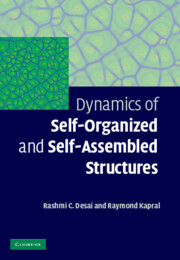Book contents
- Frontmatter
- Contents
- preface
- 1 Self-organized and self-assembled structures
- 2 Order parameter, free energy, and phase transitions
- 3 Free energy functional
- 4 Phase separation kinetics
- 5 Langevin model for nonconserved order parameter systems
- 6 Langevin model for conserved order parameter systems
- 7 Interface dynamics at late times
- 8 Domain growth and structure factor for model B
- 9 Order parameter correlation function
- 10 Vector order parameter and topological defects
- 11 Liquid crystals
- 12 Lifshitz–Slyozov–Wagner theory
- 13 Systems with long-range repulsive interactions
- 14 Kinetics of systems with competing interactions
- 15 Competing interactions and defect dynamics
- 16 Diffusively rough interfaces
- 17 Morphological instability in solid films
- 18 Propagating chemical fronts
- 19 Transverse front instabilities
- 20 Cubic autocatalytic fronts
- 21 Competing interactions and front repulsion
- 22 Labyrinthine patterns in chemical systems
- 23 Turing patterns
- 24 Excitable media
- 25 Oscillatory media and complex Ginzburg–Landau equation
- 26 Spiral waves and defect turbulence
- 27 Complex oscillatory and chaotic media
- 28 Resonantly forced oscillatory media
- 29 Nonequilibrium patterns in laser-induced melting
- 30 Reaction dynamics and phase segregation
- 31 Active materials
- References
- Index
17 - Morphological instability in solid films
Published online by Cambridge University Press: 10 February 2010
- Frontmatter
- Contents
- preface
- 1 Self-organized and self-assembled structures
- 2 Order parameter, free energy, and phase transitions
- 3 Free energy functional
- 4 Phase separation kinetics
- 5 Langevin model for nonconserved order parameter systems
- 6 Langevin model for conserved order parameter systems
- 7 Interface dynamics at late times
- 8 Domain growth and structure factor for model B
- 9 Order parameter correlation function
- 10 Vector order parameter and topological defects
- 11 Liquid crystals
- 12 Lifshitz–Slyozov–Wagner theory
- 13 Systems with long-range repulsive interactions
- 14 Kinetics of systems with competing interactions
- 15 Competing interactions and defect dynamics
- 16 Diffusively rough interfaces
- 17 Morphological instability in solid films
- 18 Propagating chemical fronts
- 19 Transverse front instabilities
- 20 Cubic autocatalytic fronts
- 21 Competing interactions and front repulsion
- 22 Labyrinthine patterns in chemical systems
- 23 Turing patterns
- 24 Excitable media
- 25 Oscillatory media and complex Ginzburg–Landau equation
- 26 Spiral waves and defect turbulence
- 27 Complex oscillatory and chaotic media
- 28 Resonantly forced oscillatory media
- 29 Nonequilibrium patterns in laser-induced melting
- 30 Reaction dynamics and phase segregation
- 31 Active materials
- References
- Index
Summary
The growth of thin solid semiconductor films is at the heart of the development of modern electronic and optical devices. A key element in strategies for nanoscale fabrication is the exploitation of growth and kinetic instabilities to form surface nanostructures and patterns with desirable functionality.
Epitaxy is a term that is commonly used for the growth of a thin solid layer on top of a substrate. Homoepitaxy denotes the growth of crystals of a material on a crystal face of the same material, while the term heteroepitaxy is used if the materials of the substrate and the growing film are different. Molecular beam epitaxy (MBE) is a common experimental technique that is used to grow such solid films. A film that grows without defects is called a coherently grown film. In such a film the constituent atoms arrange themselves on top of the substrate as its natural extension. The film has the same crystal structure as the substrate.
In the epitaxial growth of a crystal film on another crystal, elasticity plays a dominant role and leads to long-range effective interactions between the adatoms on the surface. These interactions are repulsive and compete with the stronger shortrange chemical interactions. The repulsive nature of the long-range interactions can be qualitatively understood as follows. Consider a planar solid surface of a semiinfinite crystal. When an adatom is placed on this surface, its interaction with the atoms in the top layer creates a stress which changes the distance between its nearest neighbors in the top atomic layer of the surface.
Information
- Type
- Chapter
- Information
- Dynamics of Self-Organized and Self-Assembled Structures , pp. 140 - 156Publisher: Cambridge University PressPrint publication year: 2009
